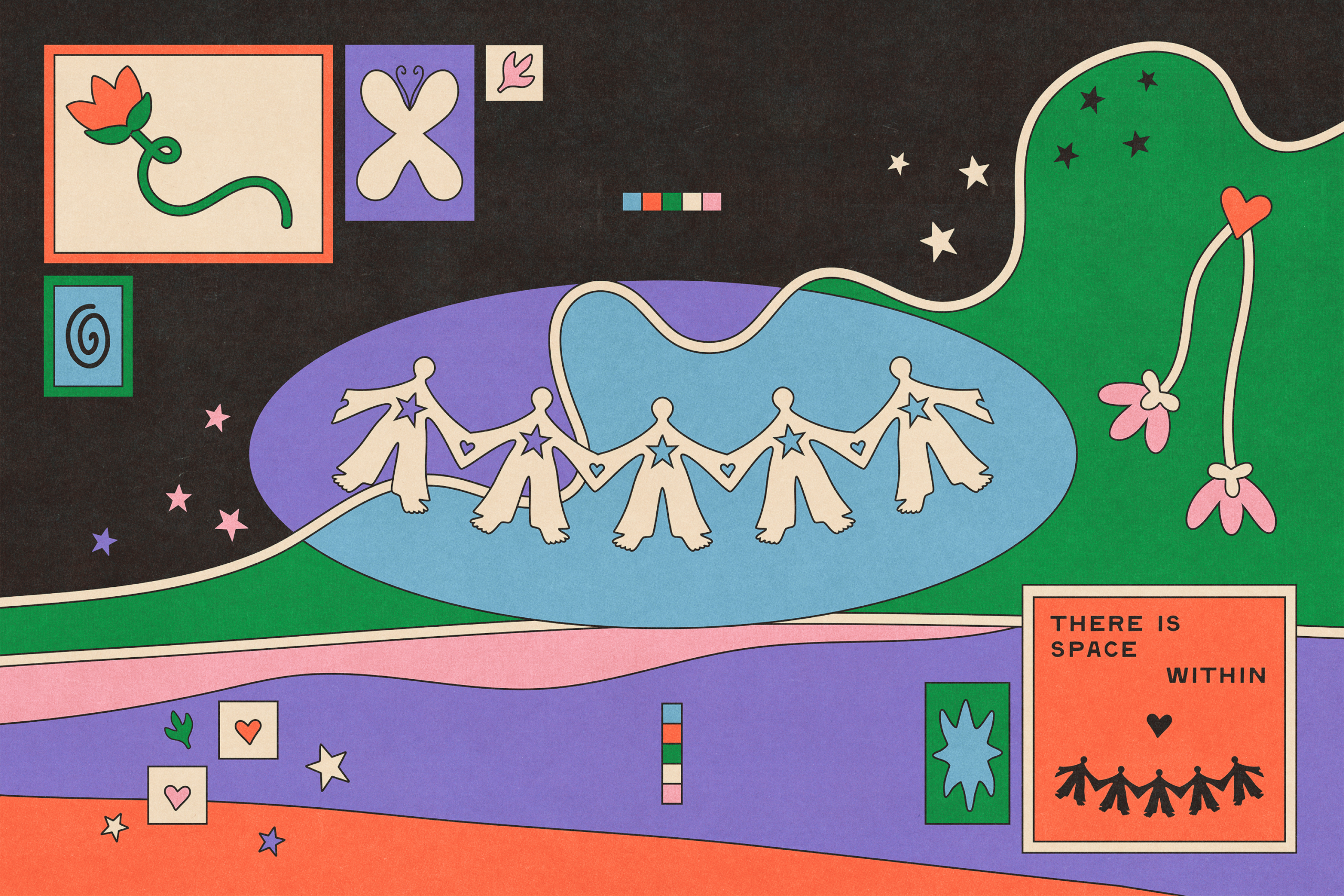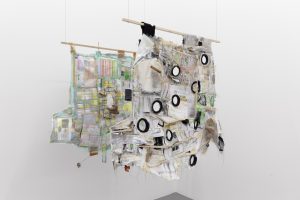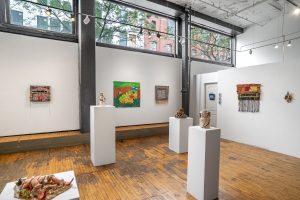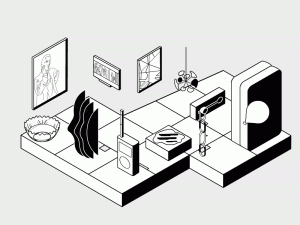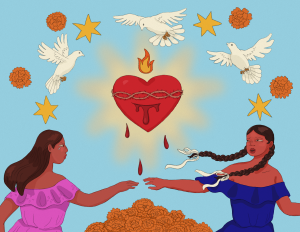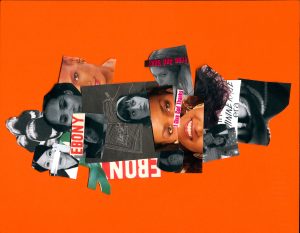Chicago-based disabled, bakla Filipino-American poet Rob Colgate’s debut poetry book Hardly Creatures splashed onto bookshelves in May, and I have to be honest: it’s been a while since a poet’s first collection made such an impression on me. There is a seismic paradigm-shift present within its pages, a richly abundant and playful book which reimagines what a book can be from a crip perspective. Responding to access dead-ends with a panoply of possibilities and interventions, Hardly Creatures stages an accessible “gallery of our own” I didn’t want to leave. The imagination of form is a refreshing realization of what intentionality can look like in making art for disabled people, not only as an intended audience but also as collaborators. These poems make room for care, and make the case that accessibility and formal experimentation go hand in hand.
As a queer and disabled poet, I was personally invigorated, challenged and moved to think through questions around accessibility and aesthetics in my own practice, including the process of preparing to release my own debut book. So it felt like a gift to correspond with Colgate via email while they embarked on their book tour.
~~
Noa Fields: Can we start by talking about Tangled Arts + Disability, the gallery in Toronto? I first met Sean through an accessible art and curation course offered during the lockdown, and later got to work with Sean and Max for a virtual conference Tangled co-hosted on publishing and accessibility. So much of what I’ve witnessed from Tangled (alas, so far, only from afar; I’ve yet to go in person!) has felt intimate and expansive, especially in contrast to how physically inaccessible Chicago as a city can be. There’s a gorgeous sestina in your book reflecting on your experience working on their first in-person event, and the picture you paint of the scene is so heart-full and sensory-rich in conveying the event as crip world-making. I’m curious to hear more about both how you got involved in the space, and its impact on you?
Rob Colgate: Oh, I love that you know Sean and Max! They are true gems.
My life is turtles all the way down, except instead of turtles it’s generous mentors taking unreasonable risks on me. I was an aimless MFA student who cared very little about publishing a book and much more about getting to write all the time. At the same time, Toronto kept coming up in my disability studies coursework. So when I went hunting for a way to keep writing after grad school, I saw a video of Sasha Velour talking about her Fulbright scholarship and went, “hmm”… A fabulous thesis advisor connected me to a colleague of hers in Toronto, who I cold emailed asking if she would do a ton of administrative legwork to facilitate me, a total stranger, moving to her country to work with her. And she said sure, sounds great! It was her who then tossed me over Tangled who, again, somehow, agreed to take me on based on an email and a Zoom.
When I got to Canada, my Fulbright placed me as a research affiliate of Toronto Metropolitan University’s School of Disability Studies and poet-in-residence at Tangled. I was there to vaguely “do some writing” about and within the “local disability community.” A few months into hanging around the Tangled gallery, going to staff meetings, and wandering through art installs, I realized the book should just be the gallery. I became fascinated with how visual art could be about disability in content while also accessible in experience. Closed captioned movies about amputation, tactile sculptures of pill bottles to be handled by those who privilege touch over sight. I wasn’t seeing anything of the sort in disability poetics, just poem after poem about disability in conventional forms. So I figured, I would give it a shot.
Writing that sestina was so fun. I was at a Korean dessert café in north Toronto until 3am. It was terribly overwrought until I put it into sestina form. It was the first poem from the book to find a home in a literary journal. Mostly, it was a chance to synthesize a lot of what I had observed at the gallery and its extended universe into the single event of a poem. I love the power of a poem to hybridize arrays of experiences into a singular, truthmaxxed artifact.
NF: Your book begins with the experience of denied access (“We do not enter the gallery”) is a fraught acknowledgment of access failures, strung by negotiated negations and exclusions. When I read that title, I anticipated a counterfactual account of what could have been possible if access had been a priority. But instead your poem details incidents avoided by not going in; highlighting all the hellish obstacles within an inaccessible gallery. Not a potentiality, but a noticing of crip being and attempts at belonging—not on the inside but on the outside, beyond the white walls, where there’s so much that happens in the world which is so disabled, forms of witness and kinship, accountability. There’s a feeling even of—relief, maybe?—in the course of describing all of what’s not happening. How would you describe this offering in the book’s entryway?
RC: This poem, like so many in the book, was stirring beneath the surface for months before I actually wrote it. I spend a lot of time percolating. In February 2023, I went to the Rhubarb Festival at Buddies in Bad Times Theatre in Toronto and saw a performance piece by the artist Laura Fisher that involved people lying down onstage cradling heat-warped metal, all beneath a narration using the same negative, anaphoric structure of “We do not…” I’m curious about embrace lack as a mode of moving through the world, and the ecstatic possibility therein. Disability is inherently framed by absence—even the word itself. If disability can function in its full truth as a negation, I knew a poem must be able to as well. I’m obsessed with what I do not have. It means there is space within me, and I get to choose how it does or doesn’t get filled. It means there are things that I cannot do, and I get to decide what happens instead. It is empowering, to lack.
The poem also didn’t feel like I was doing a bit, per se. So many of the activities described in the poem never happen because we don’t make our way to them. There are certain inaccessibilities that we never experience because of larger inaccessibilities keeping us from them. Access is this endless tunnel—intimidating, to think how much work might be necessary to truly accommodate, and thrilling, to know how much opportunity there is to care for each other.
NF: “Accessibility as aesthetics”—I loved picking up this phrase in your poem, which your book so vividly enacts poem by poem. In that phrase I felt a powerful resonance and renaming of access work as creative work. When you imaginatively reframe accessibility tools as forms or prompts for poetic expression—like your “Hopescrolling” poem, which presents a matrix of “alt text” descriptions of scenes of crip humor, mischief, and joy, which made me think of the “Alt Text as Poetry” workshop project (by Bojana Coklyat and Finnegan Shannon).
RC: This is another concept straight out of Tangled and my advisor Dr. Eliza Chandler. They called it cripping the arts: straying from asking “how can I make this art accessible” and moving instead towards “how might access lead me to art?” In a way, this reframing made writing the book rather straightforward. I accrued observations of access over months, then spilled them all into poems while I was a residency. The mindset functions as both a narrowing and a broadening. I knew the poems would all concern access in some way—and there is so much access to choose from. There was no concern I might be limiting myself in restricting my focus. Not just because there is always more access to frame through, but because there are always more poems to write. This book is not my last. There is plenty of time for other projects. I’d die if I stopped writing poetry, anyhow.
Hopescrolling was a rather straightforward accumulation of social media posts I bookmarked over months that engaged disability, often unconsciously. I think I made up maybe two or three of those tiled stanzas. The rest was just pure image and video description. I love that Alt Text as Poetry Workshop—it’s so clever, and at the same time so basic. It’s one of those things for me where it’s less that the two are similar, and more that they’re truly the same thing. If [the] description is rich, it’s hard to avoid the lyrical.
NF: So many of your poems play inventively with form, whether leaning into homophonic transcription in imitation of glitchy auto-generated captions, or relishing crip fashion’s dazzling images. But the play is also deadly serious, rooted in a sense of survival. What is your relationship to play, dare I say as a form of healing?
RC: Writing poems is fun. It’s so much fun. It’s all I want to do. Everything else is accessory to it. And I don’t think play excludes processing, figuring, or catharsis. I think play is actually supposed to take us there. Play takes the labor out of effort. It is a mode of intentionality that does not strap us for our capacities. All this to say: I really only write poems because it makes me feel good. And once I’ve animated them, anything that the poems do out in the world or within other people is completely up to them. I’m just here to make sure that they’ve had their needs met so they can do what they need to do.
I’m a bit addicted to form. Sometimes I find myself lineating emails. Form is such a singular part of poetry among genres, and to not engage it feels unfaithful. I can never really walk away from a poem without pressing it through a few forms like a sieve, or pouring the language into form like a vessel.
And form heightens the play within craft. Can I take these chunks of language and shape them into an arrangement that mirrors what is happening on a semantic level? I’m not just interested in saying things that feel urgent. If that were the case, I think I would write prose. I want to find a mode of communication that mirrors the urgency within the words’ definition. And playing lets me practice urgency without the urgency.
Form only heals me in the sense that it allows me to be more myself, and that is the sensation that I spend most of my time chasing.
NF: I’m drawn to the access intimacies your book outlines, including caregiving within the contexts of friendship, work, and love. I think you capture the nuance of how difficulties and pleasures might overlap in interdependency, including instances of competing access needs, like you mention in your poem “Abecedarian for the care shift I failed to show up for” (I particularly loved the way you built “failure” into the form, how “Z” never shows up in the 26th line, but instead ends in ghosting: “there is no right way to end this”). What does it feel like to include this vulnerable admission of your own failures to extend perfect access? How do you forgive yourself when you let yourself or others down?
RC: Mess was a concern of mine writing this book—not avoiding it, but finding ways to include and present it earnestly and lyrically. I am not in the business of presenting a redemptive perspective on disability. Disability does not have to be sanitized to be presentable or worthy of respect. It seemed ridiculous to foreground anything but authenticity, and the mess of care and access is an inherent part of it. If I tried to make collective care look tidy and flawless, I would be lying and people would depart from the page misinformed on disability, which becomes a form of ableism.
I think I would be more radical to put out a book of poems that wasn’t vulnerable. What the hell is the poem, then? Why would you even be a poet if you weren’t willing to bare yourself to yourself? And once I had done that through the poem, the rest of it wasn’t up to me. If other people happen to read the poem and learn about me, that’s the business of them and the poem, not me. I’ve already detached from the product. The poem will offer you much more than I will.
Also, don’t we all fail? Don’t we all let people down? I forgive myself because I’ve gone to therapy and lightened up. This has maybe been the biggest surprise of putting out this book for me. Everyone is talking about the vulnerability and I didn’t even realize it was happening. I just don’t think I put anything in the book that didn’t feel true, or apparent.
I think a lot about queerness and disability as running parallel socially, with disability just a few eras behind. Queerness used to be a disease, now it’s a social identity. Disability is usually considered a disease now, but to me it’s just like being bakla, or Filipino. And so I think people see an “out” disabled person and feel shocked, or scandalized, or like they’ve done something invasive by reading the book. But I haven’t worried about people knowing about my schizoaffective disorder since my first psychotic break. It’s just all so nbd to me, and I suppose I hope that can affect some sort of change in people, though I didn’t write this book to educate or improve people. I wrote it because I love poetry and disabled people.
NF: I cannot stop thinking about your poem [in the book], “Like Candy,” which pays homage to Tim Dlugos’s poem “G-9,” set in the AIDS hospital ward as he was dying. Your poem, set on a jog to his house, celebrates PrEP, a medicine which can prevent the spread of HIV, pills handed out “like candy” (the gay Cuban artist Felix Gonzalez Torres’s candy piles also spring to mind). How did you write with/after Dlugos’s canonical poem, and what did it feel like to commune with Tim Dlugos’s ghost (as well as other kindred spirits lost to the AIDS epidemic) on the page?
RC: This is the only poem in this book that I wrote before 2023. It wasn’t even originally in the manuscript, but we added it last minute after my editor asked to see some cutting room floor poems.
Tim has felt like a mentor to me for years, or a father figure, ever since the poet Colin Drohan first introduced me to him in 2018. Back then I was still studying neuroscience and competing on the crew team; poetry was a quiet hobby I snuck into my day in small snatches, a quick page in the notebook before bed. But I never really read or revised. I got Tim’s collected works from Nightboat and read it cover to cover. Very “you can say that?” kind of moment.
He stayed with me, and eventually I wrote this poem in late 2020. I was in a life-changing seminar with Joanna Klink about inhabiting poems, the basis of which was memorizing poems, reciting them, then writing our responses from that place of deep neural ingraining. I’ve never experienced something more generative. When I was memorizing G-9, Tim’s poem that my poem is after, I was spending a lot of time hanging out with my best friend, the poet Gabrielle Grace Hogan, on her balcony in the Austin night heat with our masks on. I remember almost crying to her about how I wish I could tell Tim about PrEP, how none of me and my queer friends are dying of AIDS anymore. And Gabbie said, well, put that in your response poem. I remember working on it every single day for a couple weeks, just because of the sheer length of everything. I remember reading G-9 to some guy I was seeing at the time and both of us feeling utterly struck and gutted on his porch. I remember finishing the poem at 4am with a glass of rose tea and feeling my heart shift in place within my ribcage. And a few months later another dear friend tattooed “G-9” on my ankle opposite from my “F25.0” tattoo, which is the diagnostic code for schizoaffective disorder.
My three years in Austin were some of the most brilliant of my life, and this was one of the most meaningful stretches of time within it. At the same time, I think my MFA would’ve been worth it just for this poem. It changed my understanding of what a poem could be, and what I [thought a] poem that I wrote could be.
And I really did jog to his old house when I lived in New Haven, though I would never wake up early to do so like in the poem.
NF: Benches are magical spaces of rest, and I was so moved by the ways you work them into your book as an act of care for the readers. Obviously not three-dimensional benches, but even just the conceptual thought-space of a bench as an extension of permission. Can you tell me more about how rest shows up in your poetry life as a writer and reader?
RC: [When I was] pulling the book together, I paid a lot of attention to my own sensations while reading poetry collections, or submissions for literary magazines. I noticed when I got tired and what made me feel like I couldn’t go on. Patterns emerged, and I avoided those patterns in putting my book together so that, hopefully, folks would similarly feel that they weren’t being taxed by how the book was requesting it be read.
In terms of the benches, I was sort of bloodily spurting out these love poems while writing the book. I knew the book wanted to resist a singular narrative on access, and I knew that one of its multiplicities would recognize access intimacy as a major—if not necessary—component of romantic intimacy. In my life at the time, it was becoming increasingly obvious that my new partner would be my life partner, and that a central reason we worked so well together was his ability to attend to my schizoaffective disorder as if it were nothing more than picking up laundry: a task, but not one that carried any sort of resentment, one that he was happy to do if needed. He cooks, I clean. He makes sure I take my meds, I make sure his car doesn’t get towed.
There was just no way that love poems weren’t going to be a part of the book. Same with benches. I knew every wing would need a bench, because in an art gallery, every room should have a bench. I thought, well, what brings me rest that I could put into a poem then interpolate into a bench. Oh—love.

About the author: Noa Micaela Fields is a trans poet with hearing aids. She is the author of the poetry book E, forthcoming from Nightboat Books. She lives in Chicago, where she frequently organizes poetry readings, makes zines, and goes out dancing. www.noamicaelafields.com
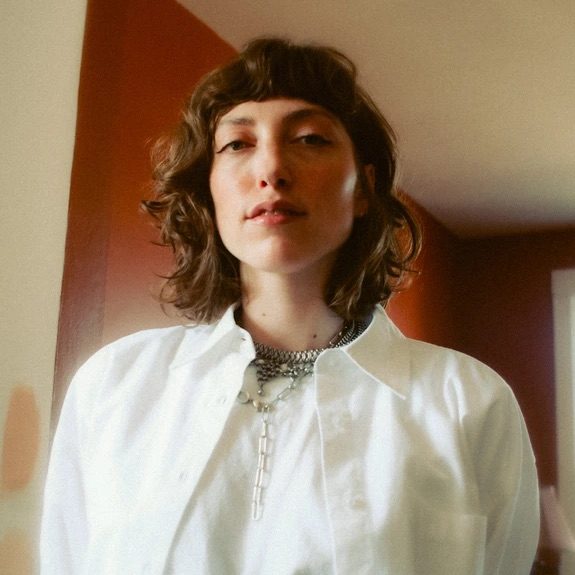
About the illustrator: Alexis Stein (she/they) is a multidisciplinary artist, designer, and community organizer based in Chicago. Her creative practice spans illustration, graphic design, photography, printmaking, and painting, often exploring themes of queerness and community. Alexis works as a graphic designer and illustrator for queer organizations and events throughout the city, using design to bring people together and build community. When they aren’t creating, Alexis spends time working as an urban designer, picking up new hobbies, and DJing whenever they can.
